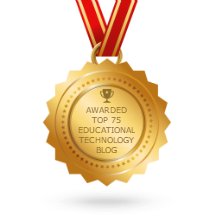A new issue alert with several K-12 blended learning items.
Analysis of short videos on TikTok for learning Portuguese as a foreign language
Yidi Zhang | Margarida Lucas | Pedro Bem-Haja | Luís Pedro
https://doi.org/10.3916/C77-2023-01Didactic audiovisual translation in language teaching: Results from TRADILEX
Alberto Fernández-Costales | Noa Talaván | Antonio J Tinedo
https://doi.org/10.3916/C77-2023-02English learners’ intentions to adopt online learning post-pandemic: Ease precedes usefulness
Isyati Suparman | Jeya Amantha Kumar | Sharifah Osman
https://doi.org/10.3916/C77-2023-03Writing, creativity, and artificial intelligence. ChatGPT in the university context
María Isabel Vicente-Yagüe-Jara | Olivia López-Martínez | Verónica Navarro-Navarro | Francisco Cuéllar-Santiago
https://doi.org/10.3916/C77-2023-04Youth digital writing on WhatsApp and the teaching of spelling
Alejandro Gómez-Camacho | Juan de-Pablos-Pons | Pilar Colás-Bravo | Jesús Conde-Jiménez
https://doi.org/10.3916/C77-2023-05Using YouTube to seek answers and make decisions: Implications for Australian adult media and information literacy
Tanya Notley | Michael Dezuanni | Simon Chambers | Sora Park
https://doi.org/10.3916/C77-2023-06Social web and photojournalism: User-generated content of the Russo-Ukrainian war
Carolina Fernández-Castrillo | Celia Ramos
https://doi.org/10.3916/C77-2023-07Incidences of artificial intelligence in contemporary education
José-Ramón Sanabria-Navarro | Yahilina Silveira-Pérez | Digna-Dionisia Pérez-Bravo | Manuel de-Jesús-Cortina-Núñez
https://doi.org/10.3916/C77-2023-08Lockdown, cyberhate, and protective factor of social-emotional and moral competencies in Primary Education
Vicente-J. Llorent | Carolina Seade-Mejía | Ximena Vélez-Calvo
https://doi.org/10.3916/C77-2023-09Analysis of media and audiences in social media facing information about suicide
Ángeles Durán-Mañes | Francisco-Javier Paniagua-Rojano | Francisco Fernández-Beltrán
https://doi.org/10.3916/C77-2023-10Comunicar is a quarterly, bilingual Spanish-English research journal, with Chinese and Portuguese abstracts. Articles, authors and topics have a decidedly international outlook. The journal now has 30 years and has published 1960 research articles. The journal appears in 809 international databases, journal impact assessment platforms,selective directories,specialized portals and hemerographic catalogues… Rigorous and transparent blind system of manuscript evaluation, audited in RECYT, International Scientific Council and a public network of 1046 reviewers from 52 countries from all over the world. Professional management of manuscripts is undertaken via the OJS 3 platform, with ethical commitments that ensure transparency and timeliness, antiplagiarism (CrossCheck), alternative metrics (PlumX, Dimensions)… High visualization level powered by numerous search engines, DOIs, ORCID, dynamic pdfs, epub, XML… with connections to Mendeley, RefWorks, EndNote, Zotero and scientific social networks like Academia.Edu or ResearchGate. Comunicar specializes in educommunication: communication and education, ICT, audiences, new languages; there are specialized monographic editions on the most updated topics. It has a double format: print and online; The digital edition offers full text, open access for the entire scientific community and researchers around the world. In English and Spanish edited by Comunicar, a professional, non-profit association, veteran in Spain (34 years) in educommunication, which collaborates with multiple institutions and international universities. In active indexations in 2022, Comunicar is top worldwide: 2nd in the world in SCOPUS and 10th in the world in JCR (top 1% and 7% in the world; percentile 99% and 93%). In JCR-JIF it is Q1 in Education, in Communication and in Cultural Studies (1st in Spanish). In SJR is Q1 in Education, Communication and Cultural Studies (1st Spanish in all three areas). It is 1st in FECYT Metrics; 1st in DIALNET METRICS. In GOOGLE SCHOLAR METRICS is the 3rd journal indexed in Spanish in all areas; 2nd in REDIB (out of 1,199 journals).
We must ensure that you wish to continue to receive our news, communications, newsletters and promotions. Since we wish to keep you informed about any news produced in Comunicar Journal, we will understand that you wish to continue receiving our communications. However, if you have changed your mind, you can cancel your subscription from the bottom of this email in the UNSUBSCRIBE link.































 12 Unique Blogs Are Written By Professors
12 Unique Blogs Are Written By Professors